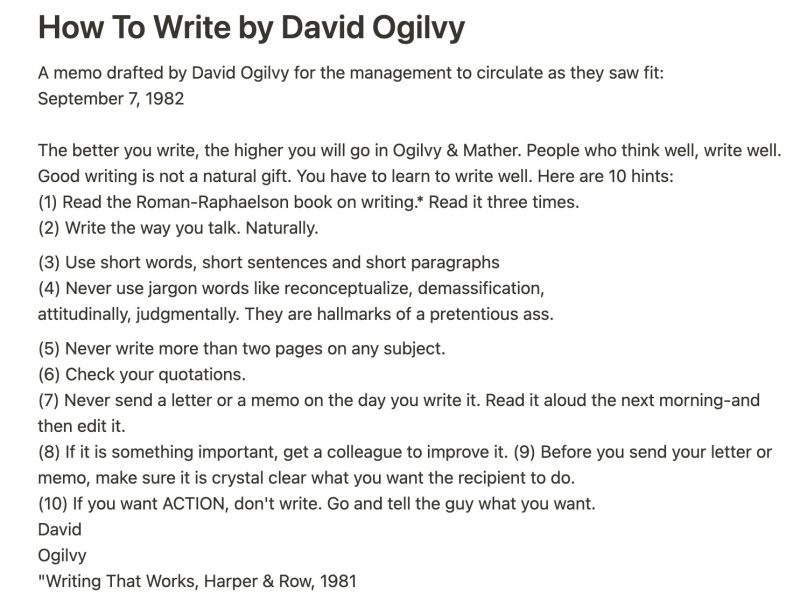
When I started writing blog posts in 2014, I had no idea what was good or bad writing. Later in 2018, I realized that my writing was not up to the mark, and required improvement.
Every day, I read articles on NewYork times, Medium, and other publications. Also, two books that really helped were – On Writing By Stephen King and the Elements of Style by William Strunk.
I am still learning and consider myself a beginner. English is neither my primary language, nor I ever emphasized learning it throughout my life.
But being a blogger is of no use if you can’t write comprehensible content. I love the works of Ernst Hemingway and how he clearly puts his thoughts across. There is no need for complicated words or jargons to make your writing stand-out. It needs to have simplicity and clarity.
I am not a master at writing, but here are some of the things that I have learned that vastly improved my writing.
You can learn these, write them down, and implement them in your work to get better at writing.
Read as you write
After writing a sentence, it is important to read it once. It will help you quickly iron out any minor mistakes, spelling errors, or sentence formation issues.
I usually do this if I know I am not going to spend much time editing it later. This works well when I am pressed for time or want to publish quickly.
Editing is Golden
What separates good writers from bad ones?
Editing.
Undoubtedly, Editing is golden.
If you are not editing your first draft; you’re not doing justice to your work. First drafts are invariably garbage and always need some editing.
Try editing your work, and you will see how much better is your edited work in comparison to the first draft.
Re-arrange Your Sentences & Paragraphs
At times, your next line or paragraph may not have a logical connection to the previous. It breaks the reader’s flow and digresses from the topic discussed in previous lines.
Although, this new piece is relevant to your article, however, it doesn’t make any sense in that context or paragraph. You must move it where there is a logical connection or create a separate section.
Your Spellings Can Break it
There is nothing more egregious than having spelling mistakes. There are no excuses for them. Use spell check on Microsoft Word, Google docs, or Apple Pages. There are a zillion free apps that will help you fix spellings.
Improve Your Grammar Instantly
Grammarly is a free/paid tool that is essential for all beginner and intermediate writers. It helps you spot passive voice, spelling errors, missing commas, semicolons, and a lot more.
Moreover, Grammarly is the only paid tool that I have been using for the last 3 years. It is a bit expensive but worth every penny.
Make Shorter Sentences
Shorter sentences are easy to devour. Even try to make one-word sentences. Not all your sentences should be short, use a mix of long and short sentences to make your writing easy to read, and have a natural flow.
The Flesch reading score implemented in the Yoast SEO Plugin in WordPress is superb. It will help you to do this easily.
Write About One Idea at a time
It was early morning, John got up and went to the beach, bought an ice-cream and started eating it, meanwhile he was reading the newspaper and was looking at the beautiful girls walking on the beach.
Hard to Read. Right!
Try to convey one or two ideas in one sentence. Break the sentences. Use full stop wherever you can use it effectively.
Remove the Fluff from Writing
I got the below submission from a newbie writer. It is fluffier than an unsheared sheep. The reader will get frustrated and leave it as it is hard to find substance in such writing.
Example of Bad Writing With a lot of Fluff (unnecessary details).

The article is about Vivo V19 and should have elaborated on the features and specs of the new phone. Instead, it digresses from the topic and jumps to Covid-19 and many other things that are not relevant.
Another grisly error is to describe all of the important specs in just one long sentence, without offering any details.
Remove the unnecessary thoughts, sentences, and paragraphs that don’t help the reader. It will make your writing more potent.
Use Heading and Subheadings
Reading a long piece of content can be exhausting to many readers. Heading and Subheadings are natural breaks and pointers that you must include for your readers.
Even in Books and Novels, you will see chapter names and heading and sub-heading to improve the flow and reading experience.
Also, if you are writing on the Web, you may need to do it for search engines like Google. Why? When you have heading and subheadings, Google can easily understand the topic.
Create a Flow
Writing with flow is “Nirvana”. The holy grail of writing.
Read the below sentence:
“He opened the letter, read it, and made a note of its contents.“
It is easy to read. But look at how beautifully three different ideas are woven together.
Writing with flow makes reading effortless.
It needs practice, learning from profound writers, editing your work, and putting more effort.
There are no shortcuts to this enlightened state. It will take time, but you and I will reach there one day.
Don’t Use An Extra Word
As it is crucial to reduce the fluff from your articles, it is essential to minimize words from sentences.
One of the indispensable lessons taught to editors is to cut out the extra. If your sentences have wordiness, you need to cut them ruthlessly.
Try to make sentences that are on point and straightforward. Unnecessary words and sentences make your writing weak.
One quick tip is to avoid passive voice and write in active voice to use lesser words.
So, that’s all from my side, share your thoughts in the comments below. If you liked the article, please give a shoutout by sharing it.
Also, you can refer to this Memo sent by David Ogilvy to his team. David was the founder of Ogilvy and Mathers and commonly referred as the father of Advertising.

Below is the text version if you wish to copy and store it somewhere for re-reading.
# How To Write by David Ogilvy
A memo drafted by David Ogilvy for the management to circulate as they saw fit:
September 7, 1982
The better you write, the higher you will go in Ogilvy & Mather. People who think well, write well.
Good writing is not a natural gift. You have to learn to write well. Here are 10 hints:
(1) Read the Roman-Raphaelson book on writing.* Read it three times.
(2) Write the way you talk. Naturally.
(3) Use short words, short sentences and short paragraphs
(4) Never use jargon words like reconceptualize, demassification,
attitudinally, judgmentally. They are hallmarks of a pretentious ass.
(5) Never write more than two pages on any subject.
(6) Check your quotations.
(7) Never send a letter or a memo on the day you write it. Read it aloud the next morning-and then edit it.
(8) If it is something important, get a colleague to improve it. (9) Before you send your letter or memo, make sure it is crystal clear what you want the recipient to do.
(10) If you want ACTION, don't write. Go and tell the guy what you want.
David
Ogilvy
"Writing That Works, Harper & Row, 1981Also, Read:
Finding the Right Topic and Domain Name For Your Blog
Master These 10 Skills To Create An Incredibly Successful Blog
Should Blogs focus on Social Media for Traffic and SEO?
Learn How to Do Email Marketing the Right Way – Comprehensive Guide

